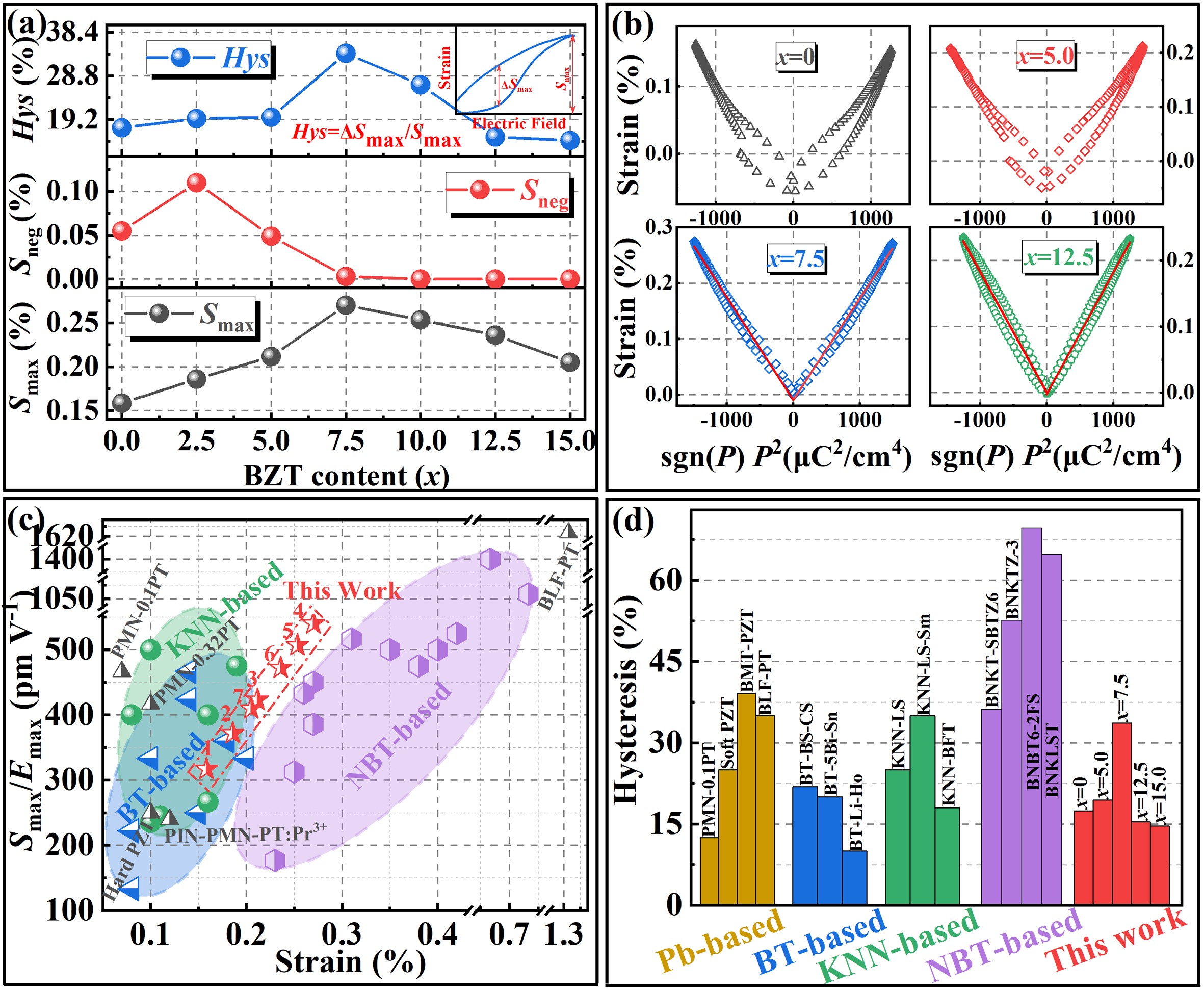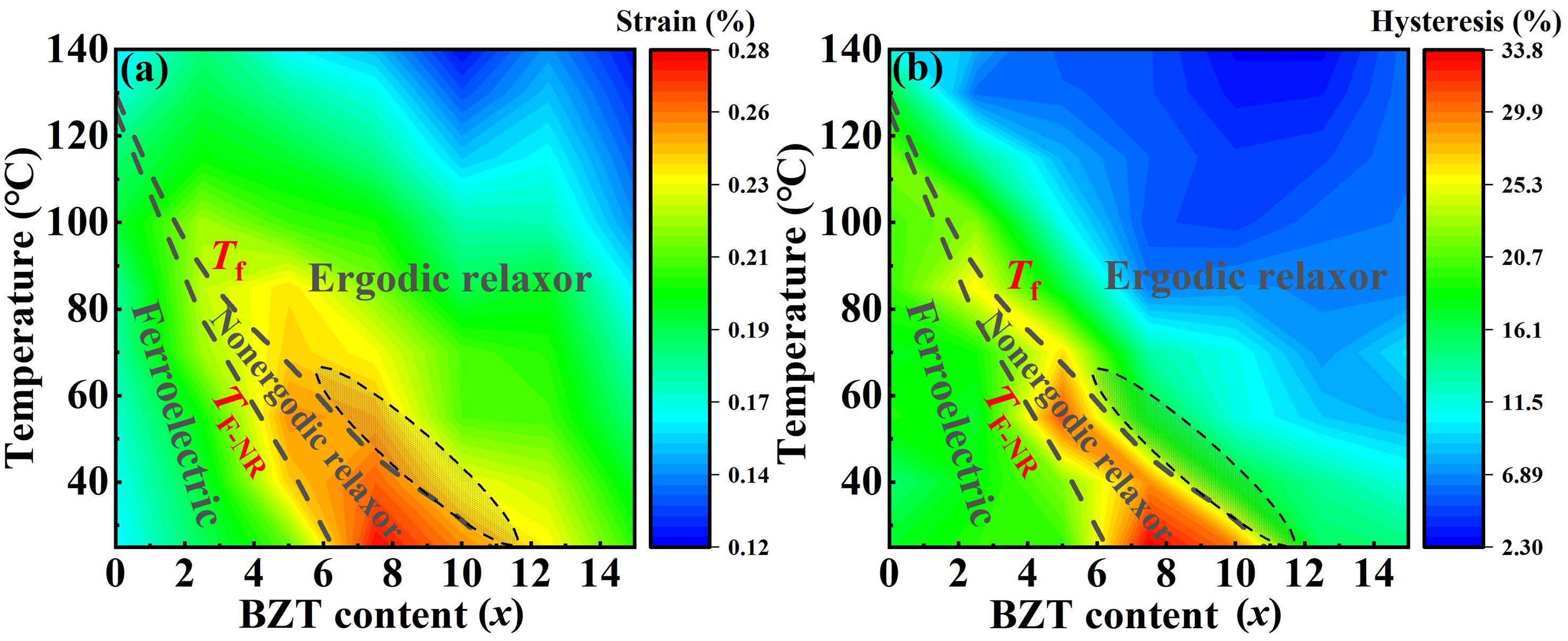| SICCAS News |
| Highlights | |
| News |
| Location:Home>SICCAS News>News |
| A Giant Electric Field-Induced Strain is Achieved with A Low Hysteresis in Relaxor Piezoelectric Ceramics |
|
|
Piezoelectrical actuator can transfer the input electrical energy into the mechanical strains, thus it is considered as one of the most potential micro-actuators due to merits of large driving force, high-precision displacement, anti-electromagnetic interference, and light weight. Undoubtedly, the electric field-induced strain (electro-strain) behavior of piezoelectric materials is a critical factor for determining the performances of actuator devices. However, due to the extrinsic contribution of the irreversible domain wall motions, the electro-strain of piezoelectric ceramics exhibits a high hysteresis under a relative high electric field, which have been a longstanding stumbling block to the commercial application in high precision actuator. Therefore, an effective strategy for reducing the hysteresis effect of macrodomains is to disrupt the long-range ferroelectric order of the ferroelectrics by modifying compositions, that is, transforming the macrodomains of normal ferroelectrics to the nanodomains of relaxor ferroelectrics. Recently, the research group from Shanghai Institute of Ceramics has made new progresses in the research of the electro-strain behavior of relaxor piezoelectric ceramics. The classical relaxor ferroelectric ceramics with the composition of 0.73Pb(Mg1/3Nb2/3)O3-0.27PbTiO3(PMN-27PT) were taken as the study object, and Bi(Zn1/2Ti1/2)O3(BZT) with a high degree of local disorder was chosen as an end member to modify phase structures and domain configurations of the system. A critical state in the relaxor ferroelectric system that enables to enhance the electro-strain and to reduce the hysteresis simultaneously was reported by systemically investigating the correlation between electro-strain behaviors and phase/domain structures. A room temperature ergodic relaxor dominated by nanodomains with different local symmetries, but remaining a macroscopic pseudocubic symmetry, can be obtained by introducing Bi(Zn1/2Ti1/2)TiO3 into 0.73Pb(Mg1/3Nb2/3)O3-0.27PbTiO3 matrix. Like the morphotropic phase boundary (MPB) in ferroelectrics, the coexistence of different local symmetries was capable of facilitating the transition from the ergodic relaxor to the ferroelectric under the applied field due to the ease of polarization rotation, thereby leading to a giant electro-stain (0.24%) under an electric field of 50 kV/cm. Furthermore, the field-induced ferroelectric state with the long-range ferroelectric order can spontaneously reverse back to the initial ergodic state during unloading the electric field, which is contributed to a low hysteresis (15.4%). This work not only provided a solid solution system with excellent electro-strain properties but also afforded a guidance for manipulating the electro-strain behavior by modulating the phase and domain structures of piezoelectric ceramics. This work was published in Journal of Materiomics This work was supported by the National Key R&D Program of China, National Natural Science Foundation of China and other projects.
Fig.1 Electro-strain behaviors of PMN-PT-BZT ceramics at room temperature.
Fig. 2 PFM images of PMN-PT-BZT ceramics at room temperature.
Fig. 3 The variation of electro-strains and strain hysteresis of PMN-PT-BZT ceramics with respect to compositions and temperature.
Reference: https://doi.org/10.1016/j.jmat.2021.01.007 Contact: Prof. LI Guorong Shanghai Institute of Ceramics grli@mail.sic.ac.cn |


